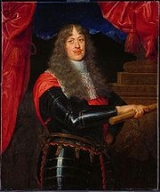
Archduke Sigismund Francis of Austria
Encyclopedia
- For other nobles of the same name, please see SigismundSigismundSigismund is a German proper name, meaning "protection through victory", from Old High German sigu "victory" + munt "hand, protection". Tacitus Latinises it Segimundus...
.

Further Austria
Further Austria or Anterior Austria was the collective name for the old possessions of the House of Habsburg in the former Swabian stem duchy of south-western Germany, including territories in the Alsace region west of the Rhine and in Vorarlberg, after the focus of the Habsburgs had moved to the...
including Tyrol
County of Tyrol
The County of Tyrol, Princely County from 1504, was a State of the Holy Roman Empire, from 1814 a province of the Austrian Empire and from 1867 a Cisleithanian crown land of Austria-Hungary...
from 1662 to 1665.
Biography
He was born at InnsbruckInnsbruck
- Main sights :- Buildings :*Golden Roof*Kaiserliche Hofburg *Hofkirche with the cenotaph of Maximilian I, Holy Roman Emperor*Altes Landhaus...
, the second son of Leopold V, Archduke of Austria
Leopold V, Archduke of Austria
Leopold V, Archduke of Further Austria was the son of Archduke Archduke Charles II of Inner Austria, and the younger brother of Emperor Ferdinand II, father of Ferdinand Charles, Archduke of Further Austria...
and Claudia de' Medici
Claudia de' Medici
Claudia de' Medici was a daughter of Ferdinando I de' Medici, Grand Duke of Tuscany and Christina of Lorraine...
. He was ordained as bishop of Augsburg
Bishop of Augsburg
The Bishop of Augsburg is the Ordinary of the Roman Catholic Diocese of Augsburg in the Ecclesiastical province of München und Freising.The diocese covers an area of 13,250 km².The current bishop is Konrad Zdarsa who was appointed in 2010....
in 1646 without being a priest. In 1653, he became bishop of Gurk
Bishop of Gurk
The Bishop of Gurk is the head of the Diocese of Gurk, which was established in 1072, as the first suffragan bishop of the Archdiocese of Salzburg...
and in 1659 bishop of Trent.
After the death of his brother Archduke Ferdinand Charles
Archduke Ferdinand Charles of Austria
Ferdinand Charles was the Archduke of Further Austria, including Tyrol, from 1646 to 1662.As the son of Archduke Leopold V and Claudia de' Medici, he took over his mother's governatorial duties when he came of age in 1646. To finance his extravagant living style, he sold goods and entitlements...
, he became Archduke of Further Austria. He was more able than his brother and could have made him a good ruler, but with his early death in 1665 the younger Tyrolean line of the Habsburg
Habsburg
The House of Habsburg , also found as Hapsburg, and also known as House of Austria is one of the most important royal houses of Europe and is best known for being an origin of all of the formally elected Holy Roman Emperors between 1438 and 1740, as well as rulers of the Austrian Empire and...
house ended. Leopold I, Holy Roman Emperor
Leopold I, Holy Roman Emperor
| style="float:right;" | Leopold I was a Holy Roman Emperor, King of Hungary and King of Bohemia. A member of the Habsburg family, he was the second son of Emperor Ferdinand III and his first wife, Maria Anna of Spain. His maternal grandparents were Philip III of Spain and Margaret of Austria...
, who as the heir male succeeded Sigismund Francis, took direct control over the government of Further Austria
Further Austria
Further Austria or Anterior Austria was the collective name for the old possessions of the House of Habsburg in the former Swabian stem duchy of south-western Germany, including territories in the Alsace region west of the Rhine and in Vorarlberg, after the focus of the Habsburgs had moved to the...
and Tyrol
County of Tyrol
The County of Tyrol, Princely County from 1504, was a State of the Holy Roman Empire, from 1814 a province of the Austrian Empire and from 1867 a Cisleithanian crown land of Austria-Hungary...
.
He married Hedwig of the Palatinate-Sulzbach
Hedwig of the Palatinate-Sulzbach
Marie Hedwig Auguste of the Palatinate-Sulzbach was a Countess Palatine of Sulzbach by birth and by marriage, Archduchess of Austria-Tyrol and by her second marriage, Duchess of Saxe-Lauenburg.- Life :...
on 3 June 1665 and died in Innsbruck twelve days later.

